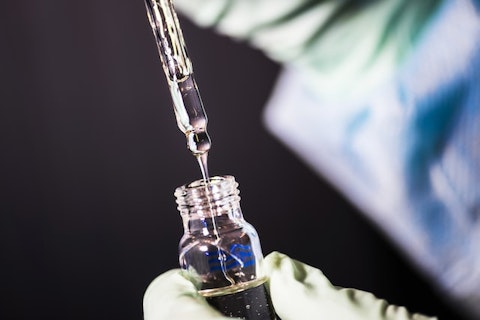Alpine Immune Sciences, Inc. (NASDAQ:ALPN) Q4 2022 Earnings Call Transcript March 23, 2023
Operator: Welcome to the Alpine Immune Sciences Fourth Quarter 2022 Earnings Call. Currently, all participants are in listen-only mode. As a reminder, this event is being recorded. I would now like to introduce Temre Johnson, Senior Director of Investor Relations and Corporate Communications at Alpine. Ms. Johnson, I’ll now turn the call over to you.
Temre Johnson: Thank you, Carrie. Good afternoon and thank you for joining us. With me on the call today are Dr. Mitchell Gold, Executive Chairman and Chief Executive Officer; Dr. Stanford Peng, President and Head of Research and Development; and Paul Rickey, Chief Financial Officer. Before I turn the call over to Mitch, I would like to remind you that we will be making forward-looking statements during today’s call. These forward-looking statements are based on our current expectations and involve risk and uncertainties as a result and the timing of events, potential publication of clinical data and expectations regarding the sufficiency of cash and investment could differ materially from those anticipated in such forward-looking statements as a result of these risk and uncertainties. You may refer to the most recent SEC filings regarding risk factors associated with these statements. Mitch, please go ahead.
Mitchell Gold: Thank you, Temre. Alpine is off to a strong start in 2023 driven by progress in the development of povetacicept, a potentially best-in-class dual inhibitor of BAFF and APRIL cytokines with a convenient once every four weeks simultaneous dosing regimen that we believe has the potential manifestations with erythematosus, autoimmune inflammatory diseases. I am pleased to announce that we recently achieved a significant milestone for Povetacicept with the initiation of the RUBY-3 basket study, a first patient-based study for the program, it will study Povetacicept in autoimmune glomerulonephritis indications including IgA nephropathy, lupus nephritis, and primary membranous nephropathy. Although still early in development, investigator enthusiasm for the program, and interest in participating in the RUBY-3 study is highly encouraged.

Photo by CDC on Unsplash
In addition to RUBY-3, we are planning to initiate the the RUBY-4 basket study an autoimmune autoimmune cytopenias in the second quarter of 2023. This includes the autoimmune thrombocytopenia, warm autoimmune hemolytic anemia, and cold agglutinin disease. We expect to share initial data from both the RUBY-3 and RUBY-4 basket studies by the end of this year. We see broad development potential for Povetacicept in multiple indications beyond the basket studies, including our RUBY-2 study systemic lupus erythematosus, as well as neurologic, dermatologic and other rheumatic disease indications. We recently signed a collaboration with Truveta to help accelerate the broad development of Povetacicept across these multiple indications. But then increasingly competitive and sometimes challenging clinical trial Truveta gives us access to its 28th partner members, who provide 16% of patient care in the United States.
In addition to our own efforts, we will leverage Truveta’s platform and analytics capabilities to more quickly identify and recruit study participants for RUBY-3 and RUBY-4 with the potential to benefit most Povetacicept. We will evoke Povetacicept has the potential to be a pipeline and project with a strong balance sheet and promising preclinical and Phase 1 healthy volunteer data, we are rapidly moving forward with a robust development plan for Povetacicept. And now I will turn over the call over to Stanford to review our progress, provide updates on our broad plans for POVI in more detail. Stanford? Thank you, Mitch. As a reminder, Povetacicept is an Fc fusion of a variant TACI domain, engineered to inhibit more potently the April and BAFF cytokines with wild-type TACI IV fusion proteins.
The clinical relevance of these cytokines continues to grow in multiple autoimmune diseases with proof-of-concept and/or encouraging clinical data is in diseases such as systemic lupus, lupus nephritis, IgA, nephropathy, Sjogren’s syndrome, and Myasthenia gravis. In preclinical studies, Povetacicept has superior to wild-type wild-type TACI IV comparators, as well as inhibitors of only April and BAFF demonstrates potent activity in multiple disease relevant animal health. At Phase 1 human study in adult healthy volunteers, Povetacicept has been well tolerated. It has demonstrated excellent PK and PD, including dose-related reductions in circulating antibody-secreting cells, and serum in globulins as well as the IgA nephropathy relevant biomarker, galactose-deficient IgA1.
Again initial multi dose experiences in each population we are initially focusing on two basket studies. The first is RUBY-3, an open-label basket study in autoimmune glomerulonephritides. This study has just recently begun enrolling. Second, we shortly follow with RUBY-4, an open-label basket study in autoimmune cytopenias. The initial data from these studies we anticipate the ability next year to begin multiple Phase 2 studies including one in systemic lupus erythematosus known as RUBY-2. Additional studies in other disease areas are of great interest, including nephrology or hematology, urology, dermatology, as well as rheumatology besides lupus. Some of these we envision could proceed via an accelerated approval pathway. In summary, Povetacicept can potently target both the April and BAFF cytokines in a unique highly differentiated way.
study that has broad development potential. We look forward to sharing additional data as the program progresses. I’ll now turn the call over to Paul Rickey.
Paul Rickey: Thank you, Stanford. I will now provide an overview of our financials for the fourth quarter ended December 31, 2022. Revenue recognized under our collaboration programs for the quarter ended December 31, 2022 was $2.8 million, compared to $4.5 million in 2021. The decrease primarily related to lower revenue recognized under our collaboration with AbbVie, partially offset by revenue recognized in the services performed in connection with our collaboration with Horizon, which was executed late in 2021. Research and development expenses for the fourth quarter ended December 31st 2022, were $18.8 million, compared to $15.4 million in 2021. The increase was primarily attributable to higher personnel-related due to increased head count to support our ongoing and planned clinical development programs.
General and administrative expenses for the fourth quarter ended December, 31st 2022 we’re $4.4 million, compared to $4.5 million for 2021. The company reported net losses of $18.9 million and $15.2 million for the fourth quarter ended 20 22 and 2021, respectively. As of December 31st 2022, Alpine’s cash and investments totaled $273.4 million, which we anticipate should be sufficient on our planned operation through 2025. I will now hand the call back to Mitch.
Mitchell Gold: Thanks, Paul. As Stanford highlighted, we are highly encouraged by the progress of Povetacicept, a milestone that we believe is the only truly potent dual /APRIL/BAFF inhibitor. As a result, we believe in the broad potential for the program may become an important immune disease-modifying therapy, present multiple be some mediated autoimmune and inflammatory diseases. In closing, we believe we have laid a strong foundation to walk to the next phase of Alpine as we progress throughout the course of this year and into next year. Operator, now open the phone for questions.
See also 18 Most Selling Phone Brands in the World and 16 Largest Pest Control Companies in USA.
Q&A Session
Follow Alpine Air Express Inc (OTCMKTS:ALPN)
Follow Alpine Air Express Inc (OTCMKTS:ALPN)
Operator: Thank you. And we’ll take our first question from the line of Mike Ulz from Morgan Stanley. Please go ahead.
Mike Ulz : Hey guys. Thanks for taking the question and congrats on getting the RUBY-3 study going here. Maybe just a question in terms of both basket studies and maybe you can comment on how you’re currently thinking about dosing. And if there’s any additional dosing work you plan to do before getting into the indication specific cohorts in the basket studies. And I guess, part of why I’m asking I looked on clinicaltrials.gov and I noticed some differences in the dosing that you’re using for RUBY-3 and RUBY-4. Thanks.
Mitchell Gold: Yes. Maybe I’ll the first part of that Mike. Thanks for the question and I’ll ask Stanford to walk you. So just as a reminder, RUBY-3 has two different dose escalations that will be going through both an 80 milligram cohort, and a 240 milligram cohort. And RUBY-4 will be going directly into the 240 milligram dosing group. So there will be no 80 milligram cohort in that group.
Stanford Peng : That’s correct. And so, there’s no, there’s no pre-indication, sort of phase of the study will be going directly into all three diseases in both trials at the doses that Mitch mentioned.
Mike Ulz : Got it. That’s helpful and maybe just one more question from me. I noticed in the press release. For RUBY-2 you plan to sort of start that study in mid 2024 and you make a comment on some – based on some enabling data from RUBY-3 and RUBY-4 studies. Maybe you can just clarify what you’re hoping to learn from those studies that will enable you to start RUBY-2?
Mitchell Gold: Primarily multi-dose data, as you know the phase one study we ran into those pending dose studies. In addition, it will give us greater confidence in to dose selection for the Phase 2 let’s say.
Mike Ulz : Good. Got it. Thanks so much.
Mitchell Gold: Thanks, Mike.
Operator: And we’ll take our next question from the line of Tara Bancroft with Cowen. Please go ahead.
Tara Bancroft : Hi guys. And thanks for taking the question. So, I’m wondering what do you expect the rate of enrollment to be in the basket studies now, especially given the Truveta collaboration? And when do you think that you might reach full enrollment? Thanks.
Mitchell Gold: Well, we’ll update it. Enrolling in general has been a challenging in a clinical trial environment to enroll patients. That being said, I’m pretty pleased with the way RUBY-3 has started. We are getting a lot of investigator interest and a lot of patient interest and I think you saw that in our comments in the press release today. So that in and of itself is encouraging. But I would say it’s purely on start of that trial but that trial continues we expect it to enroll fairly rapidly. The Truveta collaboration, I’ll talk a little bit about, Tara I appreciate you bringing that up. You know, I think we welcome to enroll the trials in a very traditional way we work with – and we engage investigators in a really active way to identify patients to bring up in the trials.
I think one of the things as an industry that we’ve done fairly poorly is using some of the new electronic medical record systems, and work organization across multiple centers to identify them quickly and then include patients in the clinical trials. Honestly, Truveta is a Seattle-based company. We know them well and work with them to kind of enable their member their member partners io identify patients that are relevant for RUBY-3 and we look forward to enroll them in our clinical trials.
Tara Bancroft : Okay, thanks.




